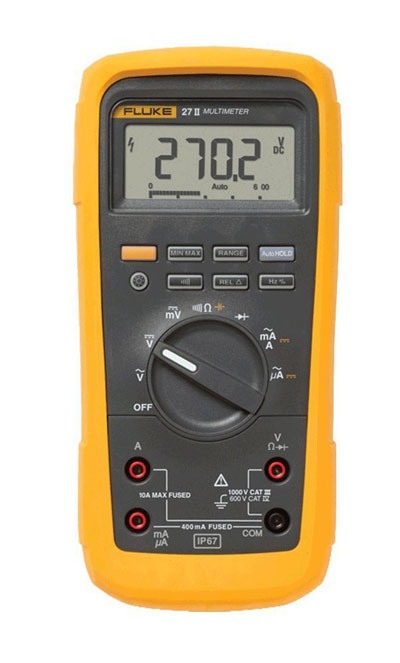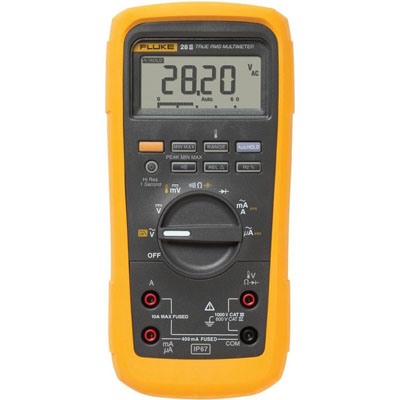When your job includes troubleshooting electronics and control systems, it’s essential to have an accurate multimeter. The best multimeters don’t just cover the basics like the voltage, current, and resistance, but also measure true RMS amplitude and AC signals while withstanding harsh conditions and rough treatment.
There’s no question that Fluke has a reputation for making the best digital multimeters around. But when the specs are similar, how do you know which one is right for the job? Let’s review these Fluke specialty multimeters and see.
What the multimeters have in common
All of the Fluke 20 Series are rugged. Both the 27 II and the 28 II are MHSA-approved for use in mines with an IP 67 dust and waterproof rating plus tolerance for a wide range of temperatures and high humidity.
They can operate down to 5°F and up to 131°F for as long as 20 minutes and still handle 95% humidity. Also, they are drop-tested to survive a 10-foot fall (while inside the holster).
The two multimeters are CAT IV and CAT III-compliant and able to measure up to 1000 V AC or DC. They also track up to 10 amps of current continuously or else up to 20 A for 30 seconds.
Both have backlit displays with min/max/avg, reading hold, and relative readings to help you manage the data. They also have the same measurement ranges like 0.1 mV to 1000 V, 0.1 μA to 10 A, and 0.1 Ω to 50 MΩ.
Beyond these features in common, there are a few crucial differences between them. Let’s contrast the individual multimeters now.
FLUKE 27 II
The Fluke 27 II has varying levels of accuracy for different measurements. For example, it’s precise down to 0.1% + 1 when checking DC voltage and 0.5% + 3 for AC voltage.
Although the DC current measurements are good down to 0.2% + 4, the AC current numbers are less precise at 1.5% +2. These are still stellar figures compared to run-of-the-mill multimeters.
But if you need maximum precision, the Fluke 28 II is more accurate than the 27 II overall. It also has an additional standout feature that might make all the difference for your job. Scroll down to learn more.
More details:
- Weighs 1.54 lbs with the holster
- Comes with three AA batteries installed
- Battery life is 800 hours
- Package includes a quick reference guide, holster, test leads, and alligator clips
- Fluke offers a limited lifetime warranty
FLUKE 28 II
On the surface, they look similar. But when you look closer at the 28 II, you’ll see that it differs from the 27 II in significant ways.
First, it’s more accurate except for AC voltage. Nevertheless, the 28 II has True-RMA AC voltage to handle non-linear signals.
Compare these other numbers to the 27 II above. For DC voltage, the readings are correct down to 0.05% + 1 and DC current down to 0.2% + 4.
Then, the 28 II has a low pass filter to eliminate noise and backlit keypad buttons so you don’t need to memorize where they are or squint in low light to see them.
Of course, you can measure capacity and resistance plus test diodes just like you can with the 27 II. Keep in mind that the waterproofing and rugged design reduce the volume of the audible tone for continuity. That’s the only fault we found as the tone is useless when working in a noisy environment.
However, the last unique feature is that the 28 II can also measure temperature and that saves bringing along extra equipment.
More details:
- Weighs 1.54 lbs with the holster
- Comes with three AA batteries installed
- Battery life is 800 hours
- Package includes a quick reference guide, holster, test leads, and alligator clips
- Fluke offers a limited lifetime warranty
Recommendation
Both of these rugged multimeters are excellent for a wide range of applications. Here’s the easiest way to decide between them.
If you’d prefer to have a built-in thermometer or need maximum accuracy, we recommend the Fluke 28 II. The backlit keys are a nice touch, too.
Notwithstanding, the Fluke 27 II actually surpasses the 28 II when it comes to accurate measurements of AC voltage.
Click here to purchase FLUKE 27 II on Amazon.com
Click here to purchase FLUKE 28 II on Amazon.com

